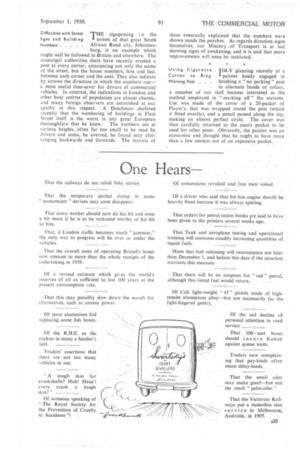Passing Comments
Page 24

Page 25

If you've noticed an error in this article please click here to report it so we can fix it.
Few Continental rEvv .Continental operators Coaches Have Come I have taken advantage this to Britain . . . summer of the relaxations per mitted to owners of vehicles brought into this country for not more than 90 days. At Southampton, a docks official said he did not recall seeing one arrive. Next year the situation may be different, because the British Travel and Holidays Association is urging foreign operators to bring parties to Britain for the Festival period. The Ministry of Transport has an International Land Transport branch at 'Berkeley Square House, London, W.1, but most of the information required by foreign operators is contained in the Public Service Vehicles (International Circulation) Regulations, 1948.
A22
Internally Mounted IN building bus and other Felt Pads Prevent I bodies with thin metal Drumming . . . panels with the object of saving
weight, there is always the danger that those which are fairly large may vibrate excessively when their periods of vibration coincide with those set up by the vehicles when in motion, or even as a result of engine harmonics. During a recent visit to the Alexander coachworks at Falkirk, where many buses are built, we noted with interest that as a precautionary measure against such trouble; felt ppds firmly secured by a suitable adhesive, are mounted on the interior of the bigger panels' and make contact with suitable parts of the body framing —a rerriedv both simple and effective.
Difficulties with.Street THE signposting i n the Signs and Building streets of that great South Numbers African Rand city, Johannes
burg, is an example which might well be followed in Britain and elsewhere. The municipal authorities there have recently erected a post at every corner, announcing not only the name of the street, but the house numbers; first and last, between each corner and the next. They also indicate by arrows the direction in which the numbers run— a most useful time-saver for drivers of commercial vehicles. In contrast, the indications in London and other busy centres of population are almost chaotic, and many foreign observers are astonished at our apathy in this respect. A Dutchman declared recently that the numbering of buildings in Fleet Street itself is the worst in any great European thoroughfare that he knew. The numbers are at various heights, .often far too small to be read by drivers and some, he averred, he found only after ranging backwards and forwards. The tenants of these eventually explained that the numbers were shown inside the porches. As regards direction signs themselves, our Ministry . of Transport is. at last showing signs of awakening, and it is said that more improvements will soon be instituted..
Using Cigarette IDLY glancing recently at a Carton to Ring painter busily engaged in Warning Post . . . finishing a "no parking" post
in alternate bands of colour, a member of our staff became interested in the method employed in "marking off" the sections. Use was made of the cover of a 20-packet of Player's, that was wrapped round the post (which it fitted exactly), and a pencil passed along the top, making an almost perfect circle. The cover was then carefully returned to the man's pocket to he used for other posts. Obviously, the painter was an economist and thought that he ought to have more than a few smokes out of an expensive packet.
















































































